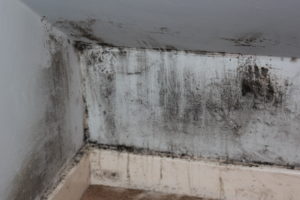 I’m going to guess, if you have an unfinished basement, the last time you were there was probably to pack away your decorations after the holidays.
I’m going to guess, if you have an unfinished basement, the last time you were there was probably to pack away your decorations after the holidays.
Unfinished basements can be damp and dark. Plus, you probably aren’t down there all that often checking the walls and foundation. Put all of these things together and you have the perfect environment for mold to sneak in and set up shop.
Before you start to panic about the possibility of basement mold, let’s go over some facts.
Basement Mold: What Causes it?
Mold is a living organism and it requires certain conditions to grow. Just like we need water, air, and sunlight to keep on living our happy lives, mold needs moisture, darkness, and poorly ventilated areas.
Basements are built below the ground and typically don’t have a lot of air flow. When it rains and water seeps into the ground, it can also find its way into the tiny nooks and crannies in your basement.
Combine that with poor air circulation and your mold is a happy camper. When the air is not circulated properly, it allows for the moisture to linger and create a humid environment.
Moisture is key to mold growth and basements have their fair share.
All of these factors cause basements to be the number one spot for mold to thrive in. Throw in the fact that you aren’t down there on a regular basis inspecting your walls, and before you know it you can have mold colonies thriving.
Getting a handle on these conditions should be the first step you take in your battle against mold.
Basement Mold Prevention
Keeping an eye out for the contributing factors to mold is your top defense.
Start by checking your basement on a regular basis. Look in the areas where it is the dampest. Shine a flashlight into any crack you might see in your basement floor and walls to see if you see the beginning of any mold growth.
Check to see if you have any leaky pipes that need to be repaired. This will assist in keeping unwanted moisture from sneaking into your walls.
You also want to check around any doors and windows as these are key places for water to leak in. Proper weather stripping will help seal your doors and windows.
Next, get some air circulation going. Basements are most damp after it rains, so keeping fans running during that time can help ventilate the area and help lower humidity levels.
Dehumidifiers are also great assets in preventing basement mold. These are inexpensive and can be purchased at most local hardware stores or from online retailers.
Wood is a perfect spot for mold to grow so if you’re storing firewood, try and keep it out of your basement. This also goes for any old clothing or books you no longer use. Mold can feed off of these items and we’re not trying to invite the mold in for a nice home cooked meal.
If you’re out of options for storage and have to store these items down there, I suggest plastic storage bins that will seal out most of the moisture. In addition, keep them away from the walls, any foundation cracks, and the sump pump.
Time to Call the Professionals?
Mold colonies can get out of hand fast and sometimes the project of mold prevention and/or removal can be overwhelming.
That’s why we’re here.
We offer individualized plans to suit your needs specifically for your mold removal. If you’re interested in having an inspection done to check for basement mold in your house, contact us today!







